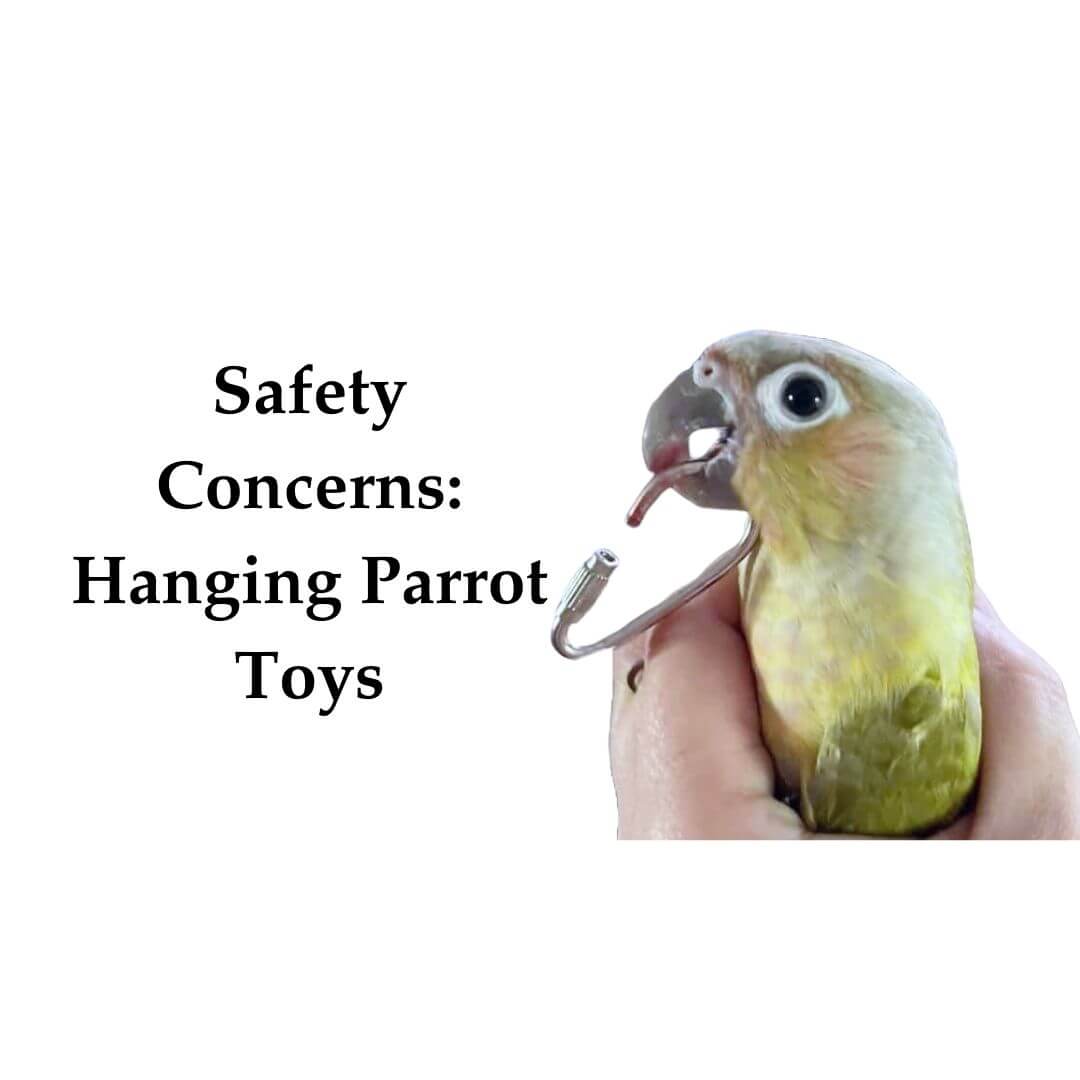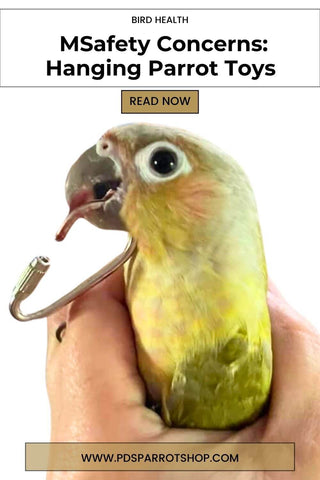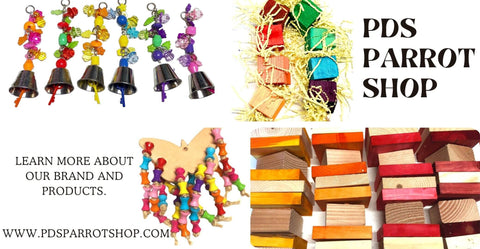
Safety Concerns: Hanging Parrot Toys
At PDS parrot shop, we are committed to providing the most extensive and valuable information about parrot care, and one critical aspect of this is ensuring the safety of the toys we provide for our feathered friends. When we talk about health, we also include things that cause harm. Pear links that come with parrot toys are extremely harmful. In this comprehensive guide, we will explore the essential safety concerns with hanging toys for parrots and provide you with actionable tips to ensure your parrot's well-being and happiness.

The picture above demonstrates the importance of using the correct hanging link to hang toys within the parrot's cage. Pear links, in the picture above, are NOT recommended. The problem with pear links is that they are just weakly made. They don't screw properly, are too small, and stop working after a few uses.
Understanding the Importance of Parrot Toy Safety
Parrots are highly intelligent and curious creatures that love to explore their surroundings. Providing them with toys is an excellent way to stimulate their minds and prevent boredom, but it is crucial to prioritize their safety while doing so. One thing parrots like to do is undo the links which are used to hang bird toys. Unsuitable or poorly constructed hanging links can lead to accidents, injuries, or even life-threatening situations for your beloved parrot. The problem comes when these pear links get caught in the beak or other parts.

Pin Me
Quality Materials Make a Difference
When it comes to hanging toys for parrots, the choice of materials is of utmost importance. Always chose bird-safe materials for your hanging links, such as stainless steel, untreated rope, nickel plated or plastic. Ensuring the links are free from any toxic substances is vital for your parrot's health.
Regular Inspections and Maintenance
Once you have set up your parrot's cage with hanging toys, the responsibility does not end there. Regular inspections are necessary to ensure that the hardware for hanging toys remain in good condition. Parrots are known for their powerful beaks, and they can sometimes damage their the hanging links during play. Replace any hanging links showing signs of wear and tear to prevent potential accidents. If using rope, make sure there are no loose ends and cut off all extra.
Pear links usually stops working after a while and doesn't tighten after a few uses. Another reason why they are not recommend.
What hardware is recommend for hanging bird toys?
First, the most comparable recommendation will be Quick Links.
These are thicker, the threads don't strip, are larger, and easier to tighten with PLIERS.
No matter what. All links must be tightened with pliers and not your hands.

Plastic Links are another recommendation. These have been great with medium size parrots. Once again, use pliers to tighten them when hanging toys, swings or nets. Update: PDS rescued a Macaw and were tested to be safe with him. Each parrot is different and results can vary with your bird.

For the links with the hole, make sure you cover it with a bead. And alway check for wear and tear on links and toys.
Other options for hanging parrot toys
There are other ways to hang parrot toys in your cage or birdie gym. Bird parents have stopped using links altogether, and they hang the bird toys or bird stuff using safe stringing material. You want to use natural fiber rope: manila, sisal, jute, or paper rope. Just have to make sure the material wasn't made with any chemicals or oils. When using rope, make sure you don't have any loose ends which can be hazardous. Cut the ends off by the knot so no rope is hanging.
If two pliers, you can use unwelded O-rings, an o-right with a slit so you can twist it open and close completely.
I am sure there are other creative ways to hang toys. Remember that even recommendations have to be used with caution because they can also be dangerous if not used right. However, pear links are the worst and have caused many issues where parrots needed surgery.
Conclusion
Safety should always be the top priority when choosing and using hardware for hanging toys for your parrot. By selecting high-quality materials, regularly inspecting and maintenance, you can create a safe and enjoyable environment for your beloved companion.
Due to the dangers of pear links, pds parrot shop no longer uses links. Explore our collection of handmade bird toys designed for parrot safety and enrichment.
More Articles on Bird Toy Safety
Even the safest toys can become dangerous if neglected—learn how to extend their life with our guide on How to Clean Bird Toys.
If your parrot loves shredding or chewing its toys, don’t worry, find out why Destroying Bird Toys is Actually Healthy for them.
Want to create your own safe hanging toys? Follow our step-by-step DIY Bird Toy Guide to craft enrichment toys your bird will love.
Monika Sangar, MSc – Molecular Biology | Avian Nutrition Specialist | Founder: PDSnonprofit | Owner: Pds Parrot Shop
Monika Sangar is a parrot rescuer, bird food chef, and toy designer with over a decade of experience in avian care and nutrition. She is the founder of Prego Dalliance Sanctuary and the author of The Science of Avian Nutrition, a cookbook dedicated to fresh, healthy meals for parrots. Explore more bird care tips and bird toys at PDS Parrot Shop!




2 comments
I like to be a great day
Thanks for the post about toy fasteners. Another fastener I see used a lot lately are the oblong, plastic links with the opening and no way to close them. It has always concerned me that those were a hazard. I easily imagined them getting stuck as seen in the pear link photo. Until this post, I hadn’t seen the closable plastic ones. Do you think plastic links are safer than the stainless steel quick links?